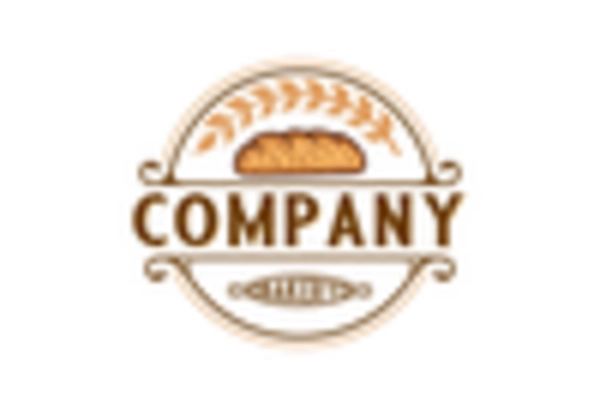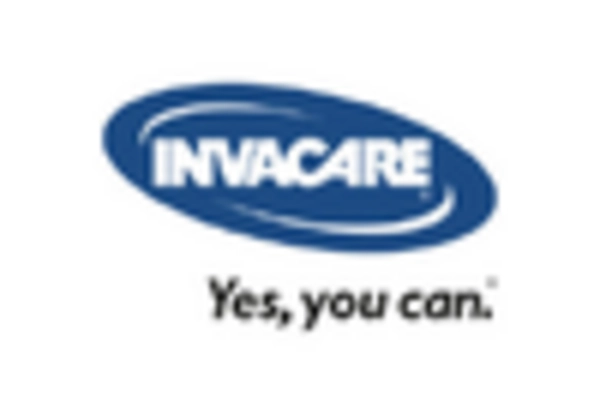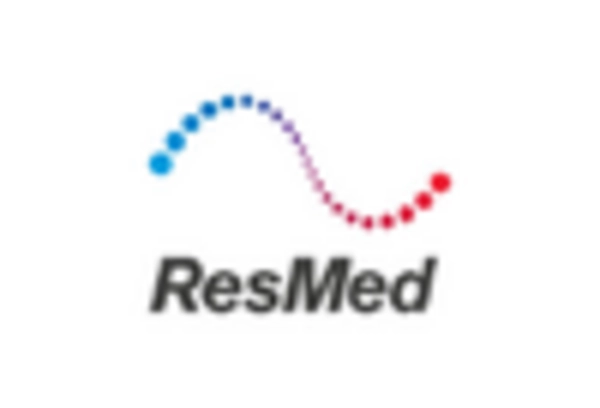Rising Prevalence of Respiratory Disorders
The increasing incidence of respiratory disorders in Italy is a primary driver for the oxygen therapy-equipment market. Conditions such as chronic obstructive pulmonary disease (COPD) and asthma are becoming more prevalent, affecting a significant portion of the population. According to recent health statistics, approximately 6.5 million Italians suffer from chronic respiratory diseases, which necessitates the use of oxygen therapy. This growing patient base is likely to boost demand for oxygen therapy equipment, as healthcare providers seek effective solutions to manage these conditions. Furthermore, the aging population in Italy, which is projected to reach 23% by 2030, is expected to exacerbate the situation, leading to an increased need for oxygen therapy. As a result, the oxygen therapy-equipment market is poised for substantial growth in response to these demographic and health trends.
Growing Awareness of Home Healthcare Solutions
The shift towards home healthcare solutions in Italy is emerging as a crucial driver for the oxygen therapy-equipment market. Patients increasingly prefer receiving treatment in the comfort of their homes, leading to a rise in demand for portable oxygen therapy devices. Recent surveys indicate that over 70% of patients with chronic respiratory conditions express a desire for home-based treatment options. This trend is supported by advancements in technology, which have made oxygen therapy equipment more user-friendly and accessible. As healthcare providers adapt to this preference, the market for home-based oxygen therapy solutions is likely to expand. Furthermore, the Italian government is promoting home healthcare initiatives, which may further enhance the adoption of oxygen therapy equipment in domestic settings, thereby driving market growth.
Regulatory Support for Medical Device Approvals
Regulatory support for medical device approvals in Italy is a vital driver for the oxygen therapy-equipment market. The Italian Medicines Agency (AIFA) has streamlined the approval process for medical devices, facilitating quicker access to innovative oxygen therapy solutions. This regulatory environment encourages manufacturers to invest in research and development, leading to the introduction of new and improved products in the market. Recent changes in regulations have also emphasized the importance of safety and efficacy, ensuring that only high-quality devices reach consumers. As a result, the oxygen therapy-equipment market is likely to experience growth as manufacturers respond to regulatory incentives and consumer demand for advanced therapeutic options. This supportive framework may also enhance competition among manufacturers, further benefiting the market.
Increased Investment in Healthcare Infrastructure
Italy's commitment to enhancing its healthcare infrastructure is a significant driver for the oxygen therapy-equipment market. The government has allocated substantial funds to improve healthcare facilities, particularly in rural areas where access to medical services is limited. Recent reports indicate that healthcare spending in Italy is expected to rise by 4% annually, with a focus on modernizing equipment and expanding services. This investment is likely to facilitate the acquisition of advanced oxygen therapy devices, ensuring that patients receive timely and effective treatment. Additionally, the integration of oxygen therapy into standard treatment protocols for respiratory conditions is becoming more common, further driving the demand for these essential medical devices. As healthcare facilities upgrade their capabilities, the oxygen therapy-equipment market is expected to benefit significantly from this trend.
Technological Innovations in Oxygen Delivery Systems
Technological innovations in oxygen delivery systems are significantly influencing the oxygen therapy-equipment market. The introduction of smart oxygen concentrators and portable devices equipped with advanced monitoring features is transforming patient care. These innovations not only improve the efficiency of oxygen delivery but also enhance patient compliance and safety. Recent advancements have led to the development of devices that can automatically adjust oxygen flow based on real-time monitoring of patient needs. This level of sophistication is likely to attract both healthcare providers and patients, driving demand for modern oxygen therapy equipment. As the market continues to evolve, the integration of telemedicine and remote monitoring capabilities may further enhance the appeal of these devices, positioning the oxygen therapy-equipment market for robust growth in the coming years.

















Leave a Comment